Exploring the Swedish Runestones
Runestones have long held a fascination for me because of my Viking blood (my father is from Sweden) and because they are some of the only remaining, visible, above-ground remnants of early Scandinavian history. Several years ago my sister and I taught ourselves the runes (the Elder Futhark), and we used them to write each other secret messages. But with as many times as I've been to Sweden in the past, I've never seen more than a couple lonely runestones standing by the road. My last trip to Sweden though was very different. This time, I was hunting them!
I was in Sweden on vacation with Ben and my parents in June of 2015 and the four of us were driving to visit Skokloster Castle, located on Lake Malaren between Uppsala and Stockholm. I was excited because it was a castle I had never been to before, and castles happen to be one of my favorite things (Sing it, Julie Andrews!). I was looking eagerly out the window when I saw a runestone flash past. And then another. And another! In the span of about 15 minutes we had passed several of them just standing by the road and signs for more that were set back in the forest. I begged if we could stop and see them all on the way back and everyone agreed.
Coming out of the castle after our tour, we wandered over to the associated church built atop a small hill. Seeing a funny shaped stone jutting out of the side of the hill, I made my way over to it and was astonished to find myself staring at a runestone. It had a large cross carved in the runes, so I guessed it was from the 10th or 11th century when Norse leaders began converting to Christianity, which would explain why the church kept it. There is just something about those weathered stones with their asymmetrical shapes and fading red, exotic letters that feels magical to me. There were two others in the churchyard that we spent some time looking at, trying (unsuccessfully) to decode.
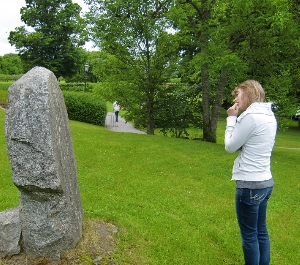
The first runestone we saw in the churchyard
of Skokloster Castle.
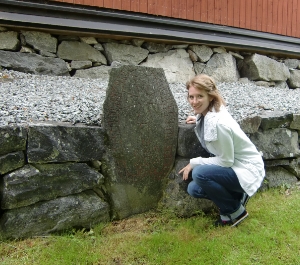
The church wall was built around this runestone.
When back in the car, we followed a sign on the road that led to what they called a rune boulder. We parked in a dirt clearing in the middle of the forest road, and it was not at all obvious where we were supposed to go. Making a guess, we followed a narrow trail that led into the forest, which was heavily overgrown and looked like nobody had been there for years. After walking for ten minutes and seeing nothing, I began to wonder if we were in the wrong place. And, as we were being eaten alive by the despicable Swedish mosquitos (I think they are more active and more evil than American mosquitos), I wondered if we should turn back. We finally came to a small clearing where we found a boulder the size of a car all covered in moss. We walked around it to see the back and were awed to find runic inscriptions that covered the entire surface! The carvings were heavily eroded but the sheer size and scope of the work was unbelievably impressive.
The next runestone we visited was just standing there on the side of the road in an open meadow. This one was amazing, it was much more complete and much taller than the ones we had seen so far. My dad (who also loves history and who is brilliant) and I spent a good 20 minutes trying to read the runes, but couldn't make anything out. I should explain, the runic alphabet is a phonetic one, and when I learned the signs I applied them to English sounds. I can get by in Swedish and my dad is fluent, but the runes were written in Old Norse, which is very different from the modern Swedish language. It was almost impossible for us to match the runes with their phonetic sounds but we had a wonderful time studying the stone and trying to make sense of it.
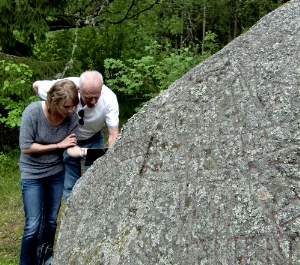
My dad and I trying to read the translation of
the boulder runestone.
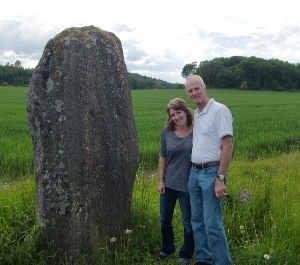
With my dad at a beautiful runestone on
the side of the road.
The next runestone we passed by was also just off the road, but it was on top of a grassy mound (undoubtedly a burial mound). The placard explained that the stone was originally found, broken, several meters away in the 1800's, but the restorers assumed the two were related so they put the stone on top of the mound. Now we know it most likely never belonged on the top, since there is not a single example in Scandinavia (to my knowledge) of a runestone being placed atop a burial mound. We climbed up to see the stone up close, accompanied by a cat that showed up out of nowhere. Despite being fragmented, the stone was beautiful with vibrant red paint in the runes. The red paint is restoration work: Analyses have shown that the runes were originally painted, either in white, black, or red, and modern restorers have chosen the red to make the runes stand out. Excitingly, this was the first and only runestone where my dad and I could match some of the runic characters to the translation on the placard! I felt just like a small Viking child first learning to read.
The last runestone we saw that day was on a small cliff just off a busy road. This one was unbelievably tall and skinny, and in good condition despite some surface breakage near the base. The translation on the placard was fascinating. The stone was raised as a memorial to several people who had died while on an expedition abroad. This was really interesting, historically speaking, since we all know what Viking "expeditions abroad" were like...
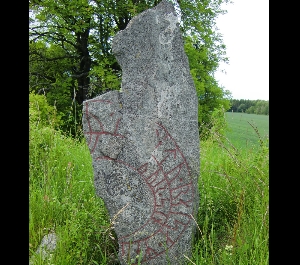
A fragmented runestone atop a grassy hill.

Ben and I by the final runestone of the day.
That was easily one of my favorite and most memorable adventures that I've had in Sweden. Living in the young United States it seems magical to come across obscure 1000-year old historic objects just by looking out the window of a car. Sweden's laws regarding the stones are really interesting, in that they are almost never moved from their original spot. If a runestone stands on private land, the landowner is required to leave the stone standing, even if it's in the middle of their plow field. So the heritage and memory of the runestones are protected across the country, and that's why you can see them dotting the landscape in the most random places. Those stones gave me such a visceral sense of the past and the world they represent. Just by being close to them I could almost imagine life as it was in the Viking Age, and it's definitely a world I want to get closer to.
